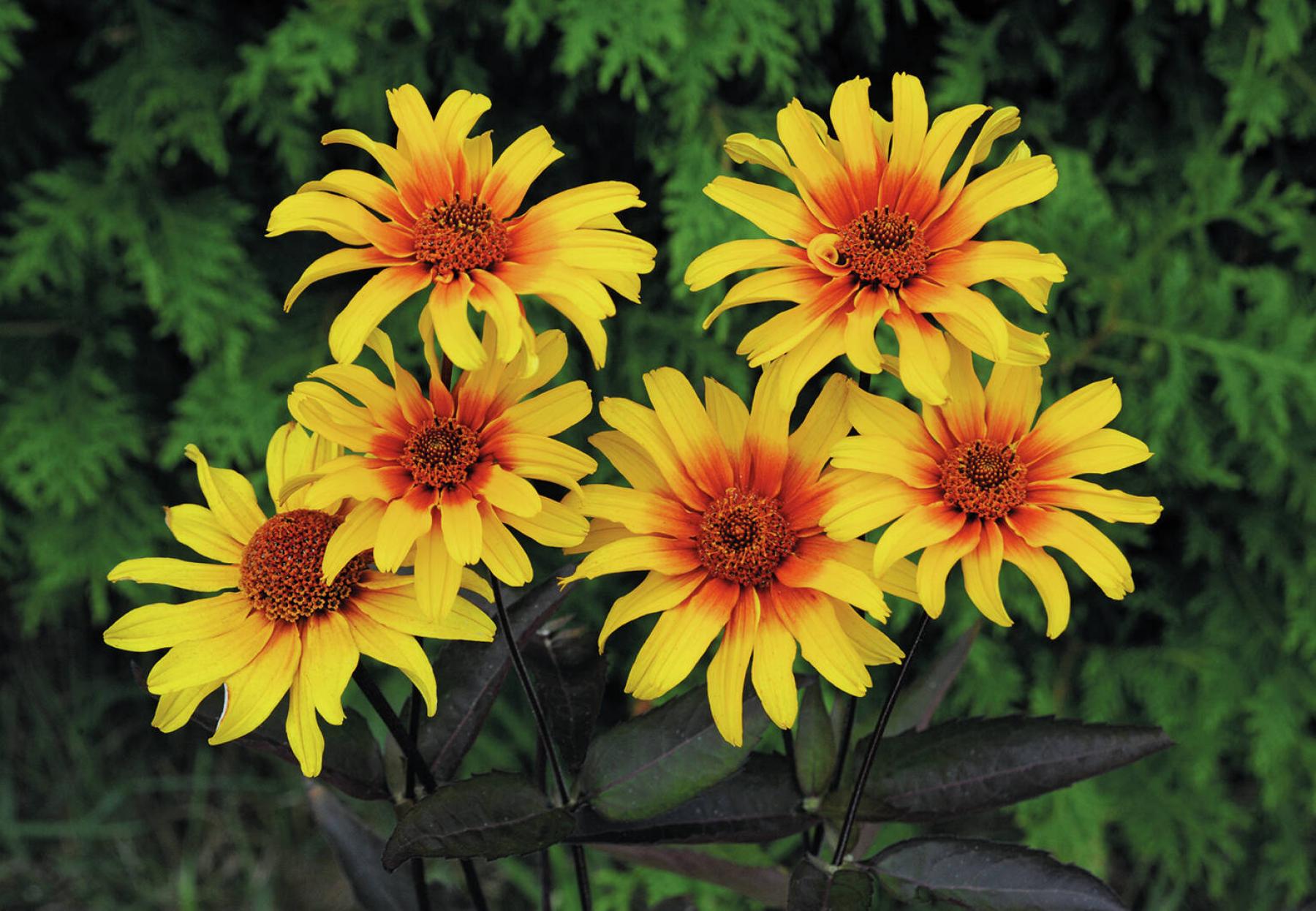In the past two years, excessively dry soil has been top of mind for gardeners in southern Manitoba. This spring, the tables are turned. Our short growing season and unpredictable weather — be it cool and wet or hot and dry — makes a stronger case than ever for choosing resilient, high-impact plants and ensuring healthy, well-draining soil.
After a spring filled with excessive rainfall, many gardeners have newly purchased plants waiting to be planted and are shopping for plants that will thrive in challenging conditions.
As eager as we may be to get our plants into the ground, it is important to not dig planting holes in waterlogged soil so that healthy soil structure is maintained.
The month of June is an ideal time to plant annuals, perennials, shrubs, and trees so there is no need to panic. Give your soil time to dry out before you begin planting and transplanting. The strong winds that are seemingly prevalent will assist in drying wet soils.
First, take steps to improve soil drainage if your soil is slow to drain and water tends to pool in certain areas. Plant roots need oxygen and standing water is a sure sign that the pore spaces in soil are filled with water.
While many plants are adapted to moist soils, a prerequisite for healthy plant growth is well-draining soil.
Autumn and early spring are a prime opportunity to improve poorly drained soils by spreading a two-to-three-inch (five to seven cm) layer of well-rotted compost over the soil surface. As the organic matter slowly breaks down, the water, air, and nutrient-holding capacity of your soil improves.
But if those opportunities were missed, what can you do now? Once the soil is dry enough to install your plants, add a top-dressing of organic mulch to the soil surface. I use a combination of natural arborist wood chips and shredded leaves. A two-inch (five cm) layer is sufficient. A mulch layer feeds the soil but also helps to prevent soil compaction.
Here are some suggestions for uncomplicated and resilient plants that deliver long-lasting performance, thrive in average to moist, well-draining soils, are beneficial for pollinators such as bees and butterflies, won’t lose their heads in strong winds, and are not favourites of both deer and rabbits. All of these can be grown in garden beds or containers in full sun. Some are tolerant of some light afternoon shade. These varieties can also be used for cut flowers and have good longevity in the garden.

ALL AMERICA SELECTION
Sweet Daisy Birdy Shasta daisy blooms reliably and is resistant to deer.Bleeding Hearts false sunflower and Burning Hearts false sunflower (Heliopsis helianthoides) are perennial plants that have zone 3 hardiness. The flowers of Bleeding Hearts emerge scarlet red and transition to orange red with red centres.
Burning Hearts has golden-yellow flowers with a red eye. Both have long-lasting daisy-like flowers supported by sturdy, black-purple stems. The long bloom season from early summer to October ensures an abundance of neverending colourful blooms. Rabbit and deer resistant, the mature height of Bleeding Hearts and Burning Hearts is about 36 inches (90 cm).
I was so delighted with the performance of both these varieties in my garden last year that now I am looking for Prima Ballerina false sunflower which has golden flowers with brown eyes. Heliopsis helianthoides is widely native in the United States and Canada. Bleeding Hearts and Burning Hearts are nativars which means they are cultivars of native plants.
Full sun is best although false sunflower will tolerate some light afternoon shade.

TERRA NOVA NURSERIES
Bred for a higher crown count, Kismet echinacea coneflower blooms all summer and into fall. Shown: Kismet Raspberry.Sweet Daisy Birdy Shasta daisy (Leucanthemum) is suitable for the front of the border. This is a hardy perennial with excellent cold and heat tolerance. A 2021 All America Selections perennial winner, Sweet Daisy Birdy grows to a height of 19 inches (50 cm) and has large, pure white five-inch (12 cm) daisy blooms with yellow button centers.
New blooms will naturally stack on top of the old blooms but deadheading may be done if preferred. Sweet Daisy Birdy blooms reliably from early summer to September and is resistant to deer. My garden is visited frequently by rabbits but it’s not the Shasta daisies they are after.

SUSAN SOUTHERN
Statuesque, Queen of the Prairie is a moisture-loving perennial with pink candy-floss-like blooms.
Echinacea purpurea Magnus is the ideal coneflower to grow in our gardens because it is a native plant and therefore well adapted to our soil and climate. But who can resist the wide assortment of coneflower cultivars that are available each year at garden centres? Alas, not I.
The Kismet series is an outstanding series of echinacea available in five colours — red, white, orange, raspberry, and yellow. Bred for a higher crown count, Kismet offers plentiful first-year blooms and good winter survivability although take note, its hardiness is zone 4. Add a protective layer of mulch around the perimeter of the plant in late fall just prior to a hard frost.
I like Kismet for its abundant blooms and long performance in both the garden and containers (early summer to October) but also for its compact size which is just 16 inches (40 cm). Kismet is deer resistant but not necessarily rabbit resistant.

PACIFIC PLUG & LINER
Delphinium Delgenius is a compact, hardy delphinium perfect for the front of the border or in containers.Grapeleaf anemone (Anemone tomentosa Robustissima) provides a dense skirt of beautiful deep-green lobed foliage in the early part of summer. By August, masses of pink buttercup flowers rise above the foliage and provide a beautiful display through to mid fall.
Deer resistant and rabbit resistant, grapeleaf anemone (some say grape-leaved anemone) loves a rich, moist, well-drained site and will grow successfully in full sun to part shade. It has a fast growth rate and a mature height of 35-47 inches (90-120 cm).
Hardy to zone 3, grapeleaf anemone is a spreading perennial so deserves room to grow. You will find no shortage of friends to readily take plant divisions if you find that grapeleaf anemone is taking up too much room in your garden.
Queen of the Prairie (Filipendula rubra Meadowsweet) is a zone 3 perennial that also has a fast growth rate and loves a rich, moist, well-drained site. It prefers full sun but is tolerant of some afternoon shade. Statuesque, Queen of the Prairie can reach a height of six feet (1.8 metres) when it is in bloom and is an eye-catching beauty at the back of the border. It has deeply divided leaves, sturdy upright stalks, and fluffy, rosy-pink blooms that resemble candy floss.
Midsummer is peak bloom time but even the spent blooms provide interest. Queen of the Prairie is a spreading perennial. To prevent self-sowing, remove the spent flowers.
Delphinium Delgenius is a compact series of delphinium with large foliage and multiple, semi-double blooms. This splendid delphinium series is the result of 10 years of breeding. Deer and rabbit resistant and hardy to zone 3, Delphinium Delgenius is available in three colours — pink, mauve, blue — and blooms well into summer.
Full sun and moist, well-draining soil is key. I grew this variety in my garden last year and it survived the winter beautifully. Try it in container gardens, too.
colleenizacharias@gmail.com
Colleen Zacharias is writing a monthly newsletter for the Free Press that will be loaded with advice, ideas and tips to keep your outdoor and indoor plants growing. Sign up to have Winnipeg Gardener delivered conveniently to your own inbox at wfp.to/wpggardener




